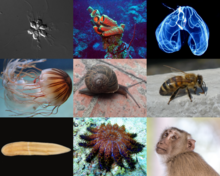
Back Choanozoa Afrikaans قمعيات Arabic قمعيات ARZ Choanozoa Bulgarian Coanozous Catalan Trubénky Czech Choanozoa German Χοανόζωα Greek Choanozoa English Choanozoa Spanish
Choanozoa
Colonie d'environ 230 individus
| Empire | Eukaryota |
|---|---|
| Règne | Protozoa |
| Sous-règne | Sarcomastigota |
| Clade | Amorphea |
|---|---|
| Clade | Obazoa |
| Clade | Opisthokonta |
| Super-règne | Holozoa |
| Clade | Filozoa |
Règnes de rang inférieur
- Apoikozoa Budd & Jensen, 2015
- Choanimal Fairclough et al., 2013
Les Choanozoa (en français Choanozoaires) forment un embranchement d'eucaryotes du règne des Protozoa.
En classification phylogénétique ils appartiennent à la lignée (ou clade) des Opisthochontes.
Les animaux (Animalia) ont émergé parmi les Choanozoa en tant que clade frère des Choanoflagellés[1]. En effet, d'après Cavalier-Smith, les phylums des Choanozoa et des Amoebozoa, peuvent être regroupés dans le sous-règne paraphylétique des Sarcomastigota, à partir duquel les animaux et les champignons ont évolué indépendamment[2].
Les Choanozoa ont été décrits comme possédant un cil postérieur[2].
- King, N., Westbrook, M. J., Young, S. L., Kuo, A., Abedin, M., Chapman, J., Fairclough, S., Hellsten, U., Isogai, Y. et Letunic, I., « The genome of the choanoflagellate Monosiga brevicollis and the origin of metazoans », Nature, vol. 451, no 7180, , p. 783–788 (PMID 18273011, PMCID 2562698, DOI 10.1038/nature06617, Bibcode 2008Natur.451..783K)
- (en)[PDF] Thomas Cavalier-Smith. Protist phylogeny and the high-level classification of Protozoa. Europ. J. Protistol. (ISSN 0932-4739 et 1618-0429) 39, 338–348 (2003) : lire en ligne
© MMXXIII Rich X Search. We shall prevail. All rights reserved. Rich X Search

